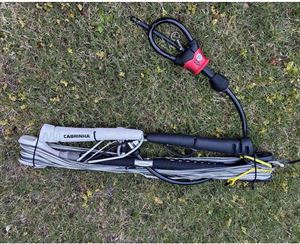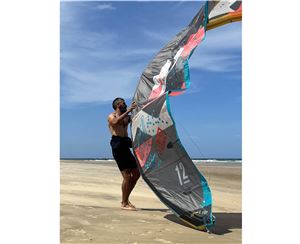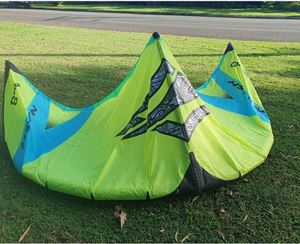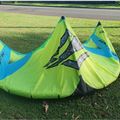How to ride toeside
 When you start out with kitesurfing, it's great to know that if things get too much you can ease out (or drop) the bar, and you'll just slow down and sink back into the water, butt first. This makes life pretty easy as you progress from the 'getting dragged out of control' phase through to the 'staying upwind' phase. But once you are cruising along nicely in control, it's time to start thinking about switching that kiteboard round and riding toeside.
When you start out with kitesurfing, it's great to know that if things get too much you can ease out (or drop) the bar, and you'll just slow down and sink back into the water, butt first. This makes life pretty easy as you progress from the 'getting dragged out of control' phase through to the 'staying upwind' phase. But once you are cruising along nicely in control, it's time to start thinking about switching that kiteboard round and riding toeside.
Riding toeside is at the heart of good kiting technique, and opens up the door to a whole new bunch of tricks. If you're riding a surfboard (or planning to once you've got things dialled on your twin tip) then riding toeside is essential - unless you only want to be able to ride waves 50% of the time! Learning to ride toeside also opens up your options when it comes to transitions (changing from one direction to the other) and it saves that, let's be honest, pretty uncool 'sitting in the water' transition.
If you've got any experience with snowboarding or wakeboarding then you may find riding toeside a bit easier, but it really isn't too hard and you should have it sorted in a few sessions. You may only go about 5 metres before you stack it on your first few attempts, but soon you'll manage 10 metres, and before you know it your knees and neck will be aching 'cos you're only riding toeside - it's addictive!
Picking the day
As with most elements of kitesurfing, things are a lot easier to learn if the conditions are right. For trying toeside riding, try to pick a day when:
There's plenty of flat water. A bit of shelter behind a breakwater is perfect or, if there's surf, ride on the inside where it's nice and glassy after the waves have broken.
The wind is nice and steady. When you first get round toeside it can feel a bit like you're walking on a tightrope - so gusts are fairly likely to knock you off...
You're nicely powered up. This is never more important than when you're learning to ride toeside: if you're underpowered then you'll just sink when you turn around. If you're torn between your 9 and your 12 - go for the 12.
The move
Okay, so you're nicely powered up, you've spotted a nice flat piece of water and there's no one else in your immediate vicinity, time to start the manoeuvre:
1. Kite position. Keep the kite at around 10 or 11 O'clock - through having it fairly high in the window, you'll naturally get a bit more lift, making your 180? easier.
2. Eye up your spot. Have a look for the exact spot where you want to begin turning your board - if there's chop then aim for the top of piece of chop to minimise the chance of catching an edge.
3. Begin transferring your weight forward slightly. When you're riding toeside your back foot (which you put most weight through) changes, so you need to start preparing for this as you begin the movement.
4. Step around. This is the tricky bit and everything happens pretty quickly - it will take a few goes before you begin to get your head around it. You need to move your board around quickly though, so 'step' your back foot quickly around so that you take the board through 180?.
5. Turn your shoulders. Follow your feet with the rest of your body. It feels a bit unnatural at first as you're facing the wrong way! But you need to forget about where the kite's pulling you and make sure that your body is nice and square over your board.
6. Adjust your weight. As you're doing all of this remember that your back foot has changed, so you need to focus on your 'new' back foot - put your weight through this.
7. Power your kite up. Regardless of how quick you are, you'll always lose some power as you make the change to toeside, so make sure your kite is powered up - give the bar a pull, or dive the kite slightly if necessary.

8. Drop the hand! Ok, maybe not on your first go, but as soon as you're feeling confident you need to drop the front hand off the bar and bring it round in front of your body: this one move will naturally twist your body around and make toeside riding a lot more comfortable (and a lot more stylish).
Troubleshooting
I can't get the board further than about 45? without catching an edge and face-planting! Kiteboards have fins, and these make things a bit trickier than turning on, say, a snowboard. Make sure you're lifting the back of the board round. As you get better (see below) you'll start to ollie 180? or use bits of chop to jump off - if you're really struggling stepping the board round, then try these.
As soon as I go round the nose of the board sinks and I go in! You've got to transfer your weight to your new back foot. As soon as you start bring the tail around, keep your weight through the foot that's still in the water. And keep your new front leg bent as you go round.
As soon as I go round my board sinks and I can't get going! This is a really common problem but don't worry: you've done the hard bit. You're stopping because you don't have enough power - make sure you've got plenty of speed as you go into the move, try and execute it quickly, and power up your kite as you come out of it.
I seem to go really slowly riding toeside compared to heelside?! Although it's important to get your weight through your back foot when riding toeside - make sure that you're not digging your back foot in too much and stalling the board. Practice moving your weight forward until you feel like yourself pick up some speed.
It doesn't feel right! Riding toeside is essentially a bit unnatural, so you need to work to get your body in the right position: open up your hips and face them forward, rotate your shoulders and drop that front arm to get things feeling right.
Progression
Riding toeside is a fundamental part of kitesurfing and opens the doors to plenty of new tricks, here are a few that you might want to take on first:
Toe to heelside transition. Come into a turn riding toeside with plenty of speed, start turning the kite and then start turning the board - as your heelside engages really dig it in to kick up plenty of spray then power up and ride off.
Ollie 180?. Once you've got your head around the dynamics of switching to toeside, start popping into the turn. Load up your edge and let the kite lift you up. This forms the basis for loads of tricks, so getting it dialled with your heel to toe transition is a great start.
Heel to toe off a wave. Use a broken or unbroken wave as a ramp to send the board up and then rotate in the air, perfect if you're lining up to do a big frontside top turn off the next wave coming through!













